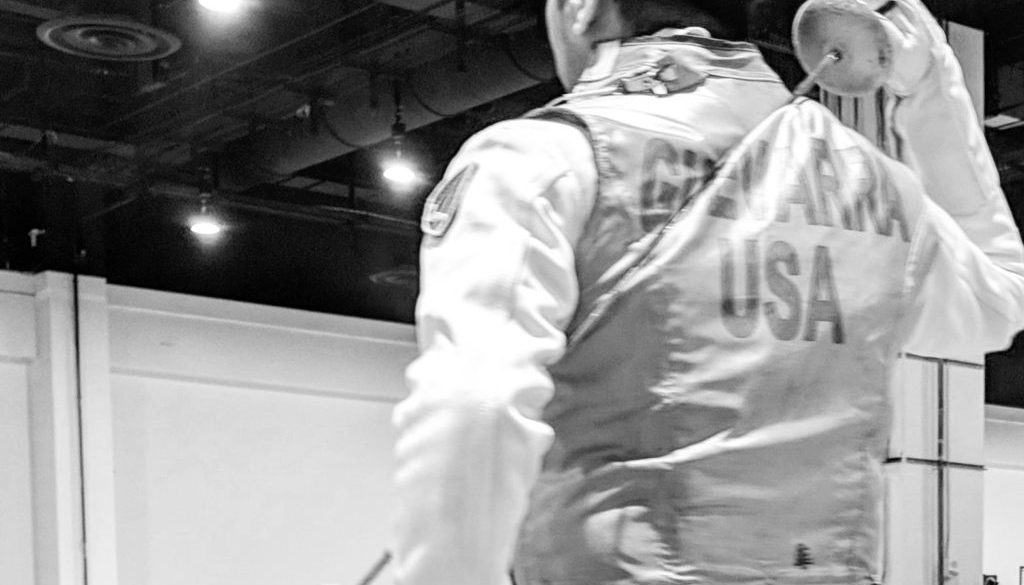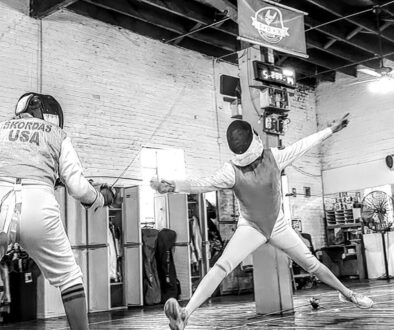On Strip/At Home Series: Visualization Techniques for Fencers
As we try to this new normal, hopefully temporarily, we are faced with many new changes. Especially in the world of sports where there is almost a gathering of more than one person. Some sports, of course, you can continue to do on your own, like going out for a run, home yoga practice, and a stroll around the neighborhood.
For many of us, fencing has been a lifetime sport, or is a major part of our lives. For some, it’s a new found sport. Either way, we are saddened that we are now limited in how we practice it, because, honestly, although it’s individual, it still requires another person to participate.
Some of us are fortunate enough to have family members we can fence with in the driveway or in the backyard. Many of us don’t. To try to keep everyone active in our sport, I’ll try to provide some training that you can do on your own.
When I (Coach Gerhard) was in high school, I ran track. Usually my events were the 1 mile and the 2 mile. If you’ve ever run races in your life, it isn’t just always run as fast as you can, you learn you have to plan the run, and of course train for it. I remember during the days of a track meet, I would sit in class visualizing my race. I would visualize the start of the race and how fast I would be running and where in the pack I would be. I would visualize how I would feel 2 and 3 laps in. I would visualize how many runners I want to see in front of me, and I would visualize how that last lap would go. How much faster I would go 1/4th into the last lap. Where I would crank it to as fast as I could go, and visualize and imaging myself starting to run out of strength on the last 100 yards and fighting through want to slow down.
As I did that, I would realize that my heart would be beating much fast and I was feeling anxious while sitting in class. I still do this naturally before any tournament weekend. I even visualize what you, my students and athletes, are doing on the strip and what I need to tell you to correct it.
Many elite athletes routinely use visualization techniques as part of training and competition. There are many stories of athletes who have used these techniques to cultivate not only a competitive edge but also to create renewed mental awareness, a heightened sense of well-being, and confidence. All of these factors have been shown to contribute to an athlete’s sports success.
Using Visualization Techniques for Better Sports Performance
Visualization has also been called guided imagery, mental rehearsal, mediation, and a variety of other things — no matter the term, the basic techniques, and concepts are the same. Generally speaking, visualization is the process of creating a mental image or intention of what you want to happen or feel in reality.
Try to visualize yourself in the bout, from start to finish. It’s going to be hard not to visualize yourself score every touch and winning 5-0. That rarely happens. So visualize yourself getting scored upon. Do you remember how you were scored upon in your last bouts whether in a competition or in practice? No visualize your opponent trying that same attack and how you will defend against it.
Imagine yourself trying a new attack that we’ve been working on in class. Imagine how you’re going to set it up. Are you advancing? Are you at a stalemate and nobody is moving? Are you in the lead? Or are you behind? What is it abou this attack that Coach Gerhard has reminded you about? Lead with the point? Hold it back? Make sure the actions are small? Imagine the point slipping past your opponents blade and hitting the target like you expected it to, not like you hoped it to.
Don’t just imagine the touches. Imagine the whole scene. These scene includes all your senses. They can be visual (images and pictures), kinesthetic (how the body feels), or auditory (the roar of the crowd). Using the mind, an athlete can call up these images over and over, enhancing the skill through repetition or rehearsal, similar to physical practice.
I do this between touches while I’m fencing, while I’m fencing, and between bouts. Then I’m able to quickly read my opponents movements, position, and greatest probable decision, imagine what I’m going to do with it, then execute it as best as I can.
Guided imagery, visualization, mental rehearsal or other such techniques can maximize the efficiency and effectiveness of your training. In a world where sports performance and success is measured in seconds, most athletes will use every possible training technique at hand. Visualization might be one way to gain that very slim margin.
Try visualization at home, not watching a fencing video. Even try visualizing training.
Also don’t forget some simple exercise to keep the body sharp at home. Remember the last one I recommended, it’s always a good baseline:
-10 advances
-10 retreats
-10 extensions
-10 lunges
Remember to do them deliberately, and not to just knock it out. This time, are you remembering to…
-Sit down and keep your knees bent?
-Do small advances and larger retreats?
-Is your knee and your foot still facing forward when you lunge?
-Can you hear your heel hit the floor when you lunge?
-Is your foot flopping down for that big slapping sound when you lunge (we don’t want that).
-Are your arm all the way?
-Are you extending before you lunge?
I didn’t specify those last time I gave you an assignment, but I want you to be mindful of these things when you’re doing them on your own. If you can remember to do these things, that’s one less thing I, as a coach, have to remind you, and we can focus on more advanced things!
Lesson for the day: Visualize yourself fencing: moving, scoring, getting scored upon, problem solving. And do the assigned footwork and bladework (without a weapon if you don’t have one, that’s ok). Remember my pointers.
Here’s another good article on Visualization: https://www.peaksports.com/sports-psychology-blog/sports-visualization-athletes/
Lastly, if you want to practice at home, now might be a good time to get, at the least, a weapon and a glove.
Here are some links:
Standard Glove (Specify if you’re left or right handed, and the size of your glove. There are links on the site to measure your hand.):
https://www.absolutefencinggear.com/shopping/product_info.php/products_id/101/cPath/15
Practice Foil:
https://www.absolutefencinggear.com/shopping/product_info.php/products_id/175/cPath/24_25
A lastly lastly, here’s a good video to watch: https://www.youtube.com/watch?v=TTx2YRt2HS4&list=PLz5seJZ8773LXmJSyvJjM-dqKZ3IcfgdX&index=2




